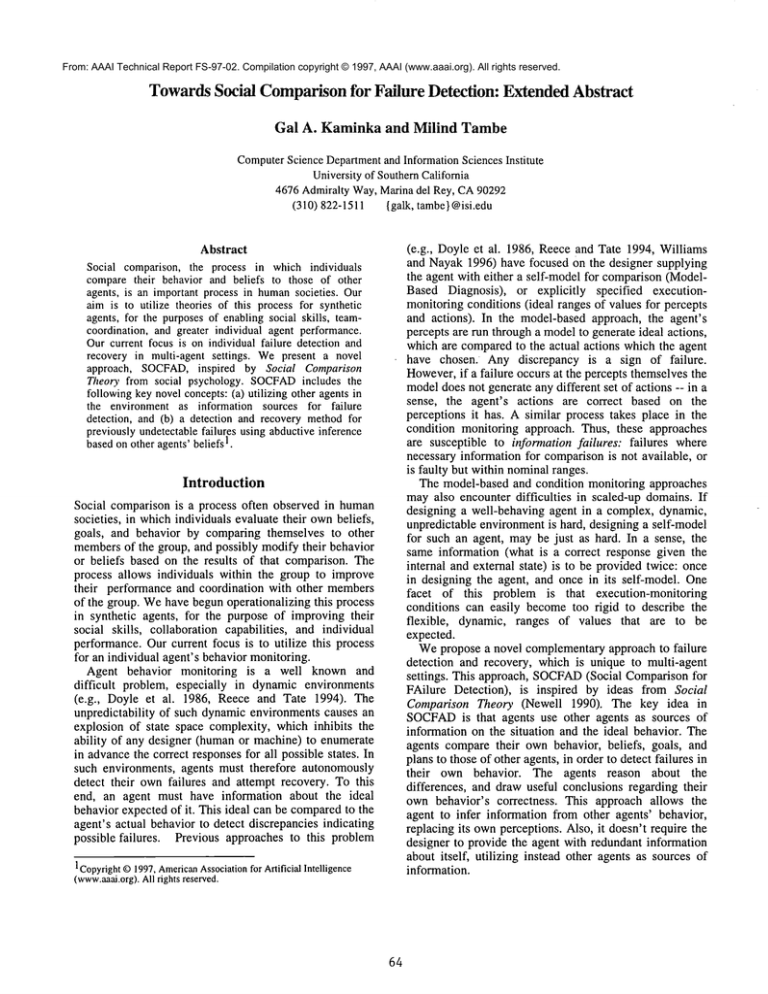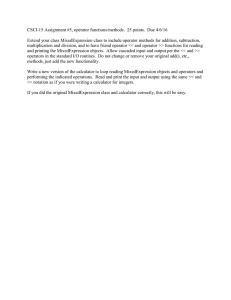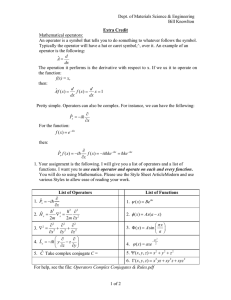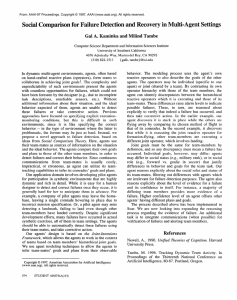
From: AAAI Technical Report FS-97-02. Compilation copyright © 1997, AAAI (www.aaai.org). All rights reserved.
Towards Social Comparison for Failure Detection:
Extended Abstract
Gal A. Kaminkaand Milind Tambe
ComputerScience Departmentand InformationSciences Institute
Universityof SouthernCalifornia
4676 Admiralty Way,Marinadel Rey, CA90292
(310) 822-1511 {galk, tambe}@isi.edu
(e.g., Doyle et al. 1986, Reece and Tate 1994, Williams
and Nayak 1996) have focused on the designer supplying
the agent with either a self-model for comparison(ModelBased Diagnosis), or explicitly specified executionmonitoring conditions (ideal ranges of values for percepts
and actions). In the model-based approach, the agent’s
percepts are run through a modelto generate ideal actions,
which are comparedto the actual actions which the agent
have chosen. Any discrepancy is a sign of failure.
However,if a failure occurs at the percepts themselves the
modeldoes not generate any different set of actions -- in a
sense, the agent’s actions are correct based on the
perceptions it has. A similar process takes place in the
condition monitoring approach. Thus, these approaches
are susceptible to information failures: failures where
necessary information for comparisonis not available, or
is faulty but within nominalranges.
The model-based and condition monitoring approaches
mayalso encounter difficulties in scaled-up domains. If
designing a well-behaving agent in a complex, dynamic,
unpredictable environmentis hard, designing a self-model
for such an agent, maybe just as hard. In a sense, the
same information (what is a correct response given the
internal and external state) is to be provided twice: once
in designing the agent, and once in its self-model. One
facet of this problem is that execution-monitoring
conditions can easily becometoo rigid to describe the
flexible, dynamic, ranges of values that are to be
expected.
Wepropose a novel complementaryapproach to failure
detection and recovery, which is unique to multi-agent
settings. This approach, SOCFAD
(Social Comparisonfor
FAilure Detection), is inspired by ideas from Social
Comparison Theory (Newell 1990). The key idea
SOCFAD
is that agents use other agents as sources of
information on the situation and the ideal behavior. The
agents compare their own behavior, beliefs, goals, and
plans to those of other agents, in order to detect failures in
their own behavior. The agents reason about the
differences, and draw useful conclusions regarding their
own behavior’s correctness. This approach allows the
agent to infer information from other agents’ behavior,
replacing its ownperceptions. Also, it doesn’t require the
designer to provide the agent with redundant information
about itself, utilizing instead other agents as sources of
information.
Abstract
Social comparison, the process in which individuals
comparetheir behavior and beliefs to those of other
agents, is an important process in humansocieties. Our
aim is to utilize theories of this process for synthetic
agents, for the purposesof enabling social skills, teamcoordination, and greater individual agent performance.
Our current focus is on individual failure detection and
recovery in multi-agent settings. Wepresent a novel
approach, SOCFAD,inspired by Social Comparison
Theory from social psychology. SOCFAD
includes the
followingkeynovel concepts:(a) utilizing other agents
the environment as information sources for failure
detection, and (b) a detection and recovery methodfor
previouslyundetectablefailures using abductiveinference
1.
basedon other agents’beliefs
Introduction
Social comparison is a process often observed in human
societies, in whichindividuals evaluate their ownbeliefs,
goals, and behavior by comparing themselves to other
membersof the group, and possibly modify their behavior
or beliefs based on the results of that comparison. The
process allows individuals within the group to improve
their performance and coordination with other members
of the group. Wehave begun operationalizing this process
in synthetic agents, for the purpose of improving their
social skills, collaboration capabilities, and individual
performance. Our current focus is to utilize this process
for an individual agent’s behavior monitoring.
Agent behavior monitoring is a well known and
difficult problem, especially in dynamic environments
(e.g., Doyle et al. 1986, Reece and Tate 1994). The
unpredictability of such dynamic environments causes an
explosion of state space complexity, which inhibits the
ability of any designer (humanor machine) to enumerate
in advancethe correct responses for all possible states. In
such environments, agents must therefore autonomously
detect their own failures and attempt recovery. To this
end, an agent must have information about the ideal
behavior expected of it. This ideal can be comparedto the
agent’s actual behavior to detect discrepancies indicating
possible failures. Previous approaches to this problem
1 Copyright
©1997,American
Association
for ArtificialIntelligence
(www.aaai.org).
Allrightsreserved.
64
Motivating
(operators) (Firby 1987, Newell 1990, Rao et al. 1993),
which form hierarchies that control each agent. The
design implements the Joint Intention Framework
(Levesque et al. 1990). Following this framework,
operators maybe team operators (shared by the team)
individual (specific to one agent). Teamoperators achieve
and maintain joint goals, and require coordination with
the other membersof the team as part of their application
(Tambe 1996, Tambe1997).
Different capabilities
and performance result by
changing the information being compared(e.g., internal
beliefs and goals vs. observable behavior). It is useful to
use information that captures the control processes of the
agents. Operator hierarchies are therefore natural objects
for modeling and comparison. The agent modeling
technique we use, RESC~,infers the operator hierarchies
being executed by other agents based on their observable
actions. Based on the representation of the other agents’
plans by operator hierarchies, the comparisonprocess can
be implemented by comparing the chosen operators in
equal depths of the hierarchies - the hierarchy of the
monitoring agent, and the hierarchies for its chosen
targets for comparison.
Differences with other agents are meaningful only to
the extent that the other agents are socially similar. Other
agents maynot be executing plans that are relevant to the
agent’s goals, and maytherefore be irrelevant for failure
detection purposes. Worse yet, other agents may be
hostile, intentionally using deception to advancetheir own
agendas. Fortunately, team memberstend to work on joint
goals and sub-plans related to the one the agent should be
executing, and can be assumed to be non-hostile. The
comparison process we use in SOCFADtherefore
considers team membersonly.
Example
Our application domain involves developing automated
pilot agents for participation in a multi-agent battlefield
simulation environment, which is highly dynamic,
complex and rich in detail (Tambe et al. 1995). These
qualities
present the agents with never-ending
opportunities for failure, as anticipation of all possible
internal and external states is impossiblefor the designer.
For example, a team of three agents arrives at a specified
landmark position. One of the team-members,whose role
is that of a scout, is to continue forward towards the
enemy,identifying and verifying its position. The scout’s
team-mates (attackers) are to wait for its return in the
specified position. Due to unanticipated sensory failure,
one of the attackers does not detect the landmarkmarking
the waiting point. Instead of waiting behind, it continues
to fly forward with the scout, following it into the
battlefield, leaving the other attacker alone behind.
Wehave collected dozens of such failure reports over a
period of a few months, despite significant development
and maintenanceefforts, including the use of somefailure
detection methods based on knownapproaches. However,
using SOCFAD,
an agent as in the example above can at
least detect that something maybe wrongby noticing that
other agents are behavingdifferently.
Social
Comparison:
SOCFAD
SOCFADis inspired by Social Comparison Theory
(Festinger 1954), a descriptive theory from social
psychology. We have begun to operationalize
it for
monitoring.
SOCFAD’s algorithm accepts inputs
representing the states of the agents being comparedtheir beliefs, goals, behavior, etc. These are comparedto
the agent’s ownstate to detect discrepancies, whichwould
indicate possible failures. Then, a social similarity metric
is used to reason about whichdiscrepancies are justified,
and to what degree. In this way, a level of certainty in the
detected failure is produced, which is based on the
expected similarity betweenthe agents.
To operationalize SOCFAD,
we therefore require: (i)
way of acquiring knowledgeof the other agents (so that
we have something to compare against); (ii) a procedure
to compare agents’ states; and (iii) a procedure for
measuring the significance of any discrepancies, based on
the agents’ expectedsocial similarity.
Knowledge of other agents can be communicated.
However, such communication is often impractical given
costs, risk in hostile territories, and unreliability in
uncertain settings. Our implementation of SOCFAD
relies
instead on agent modeling (plan recognition) techniques
that infer an agent’s beliefs, goals, and plans from its
observable behavior and surroundings.
When the
monitoring agent has access not only to its ownoriginal
beliefs, goals, plans, etc., but also to those of its group
members,the process of comparisoncan take place.
Our agents’ design is based on reactive plans
Team Operator Differences
In the Joint Intentions Framework,explicit team operators
form the basis for teamwork, requiring mutual belief on
the part of the team members as a condition for the
establishment, and termination of team operators. At the
team level, members are maximally socially similar,
requiring that identical operators be executing. Any
difference in team operators between agents in a team is
therefore a certain sign of failure, regardless of its cause.
In the exampleabove, one agent has failed to detect a
key landmark position and continued execution of the
"fly-flight-plan" team operator. However,its teammates
correctly detected the landmarkand terminated execution
of that operator, switching to the "wait-at-point" team
operator. Through agent modeling, the miscoordinating
agent infers the operators the other agents are executing.
It realizes that they could potentially be executing the
"wait-at-point" operator and detects a discrepancywith its
ownteam operator of "fly flight plan". At this point it
does not knowwhich side is correct, but can conclude
with certainty that a failure has occurred within the team
and the coordination amongits members.
65
use the agent’s own inputs to generate an ideal output
which is comparedto the actual output to detect problems
in the process converting inputs to outputs. Thusthey are
limited by the quality of the agent’s own perceptions.
However, SOCFAD
can detect such failures and correct
them as demonstrated above.
Several issues are open for future work. One important
issue is in techniques and biases useful for deciding which
side is correct where a difference is encountered with
another agent, but no information is knownto support
either side. A simple technique that may be used is to
follow the majority, so that if a majority of agents agree
with one agent, its beliefs and behavior is taken to be
correct. Such a technique has clear limitations, and
improvementscontinue to be a subject for future work.
Individual Operator Differences
In service of team operators, different agents maywork on
different individual operators. These do not carry with
them the responsibilities
for mutual belief that team
operators do, and so differences in individual operators
are not sure signs of failure, but at best indications of the
possibility. Wetherefore require additional information
about the agents causing the difference which can help in
determiningwhetherthe difference is justified or not.
Agents working towards similar goals have similar
social roles: In our example, there were attackers and a
scout. Agents with similar roles would serve as better
sources of information. Related to the social role is social
status, which mayalso justify differences in individual
operators among team members. For instance, in the
military domain agents of different ranks may follow
different individual operators to guide their behavior.
We have provided our agent with the means to
explicitly consider the social role and status of other
agents within the team in filtering and assigning weights
to the information inferred about them. For example, if
the agent is an attacker, which is one of the roles in a
team in our domain, it will assign more weight to other
agents whichare attackers.
References
1. DoyleR. J., AtkinsonD. J., DoshiR. S., Generatingperceptionrequests
and expectationsto verify the executionof plans, in Proceedingsof AAAI86, Philadelphia, PA(1986).
2. Festinger, L. 1954. Atheory of social comparisonprocesses. Human
Relations, 7, pp. 117-140.
3. Firby, J. 1987.Aninvestigation into reactive planningin complex
Towards Socially-Based Recovery
Fromthe fact that other agents are executing a different
plan, the agent can conclude with some certainty that a
failure has occurred, but it cannot tell whichof the sides is
correct. If the agent believes it is at fault, it can alter its
ownbeliefs by adopting the (inferred) beliefs of the other
agents. In particular, team operators require mutual belief
in pre-conditions, and so by adopting them the agent resynchronizes itself with the rest of the team. For example,
the agent in the landmark example overcame its sensory
problem by adopting its team-matesinferred belief in the
landmark being reached even though its own sensors
didn’t support this belief. This fulfilled the preconditions
of its own"wait-at-point" operator, which was selected
and allowed the agent graceful recovery from the failure.
domains.In Proceedingsof the National Conferenceon Artificial
Intelligence (AAAI-87).
4. Levesque,H. J.; Cohen,P. R.; Nunes,J. 1990.Onacting together, in
Proceedingsof the National Conferenceon Artificial Intelligence (AAAI1990), MenloPark, California, AAAIPress.
5. NewellA., 1990. Unified Theories of Cognition. HarvardUniversity
Press.
6. Reece, G. A.; and Tale, A. Synthesizingprotection monitorsfrom causal
structure, in Proceedings
of AIPS-94,Chicago,Illinois (1994).
7. Rat, A. S.; Luces,A.; Morley,D., Selvestrel, M.; and Murray,G. 1993.
Agent-orientedarchitecture for air-combatsimulation.TechnicalReport:
TechnicalNote42, TheAustralianArtificial IntelligenceInstitute.
8. Tambe,M.; JohnsonW.L.; Jones, R.; Koss,F.; Laird, J. E.; Rosenbloom,
Summary and Future
P. S.; and Schwamb,
K. 1995.Intelligent Agentsfor interactive
Work
simulation environments.AI Magazine,16(1) (Spring).
This paper presents a novel approach to failure detection,
an important problem plaguing multi-agent systems in
large-scale,
dynamic, complex domains. Existing
approaches often face difficulty in addressing this
problem in such domains. The key novelties of our
approach are: (a) a newfailure detection method, utilizing
other agents in the environmentas information sources for
comparison, (b) a general heuristic for team-based
comparison, and (c) a detection and repair method for
(previously undetectable) information failures using
abductive inference based on other agents’ beliefs.
The social comparison approach to failure detection
complements previous methods, being able to detect
different types of failures. In general, previous approaches
9. Tambe,M. 1996. TrackingDynamicTeamActivity, in Proceedingsof the
NationalConferenceon Artificial Intelligence (AAAI-96),
Portland,
Oregon.
10. Tambe,M. 1997. AgentArchitectures for Flexible, Practical Teamwork,
in Proceedingsof the NationalConference
on Artificial Intelligence,
Providence,RhodeIsland (To appear).
11. Williams, B. C.; and Nayak,P.P. 1996. AModel-BasedApproachto
ReactiveSelf-ConfiguringSystems.In Proceedingsof the Thirteenth
NationalConferenceon Artificial Intelligence (AAAI-96),
Portland,
Oregon.
66



